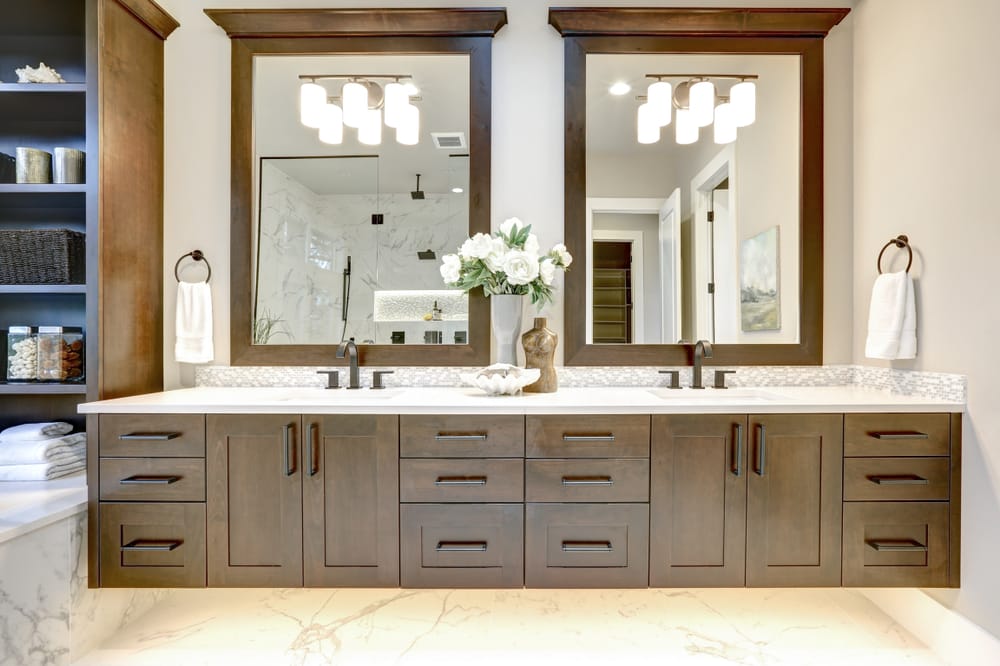Are Bathroom Mirrors Different to Regular Mirrors?
What's on this Page?
Do mirrors use tempered glass? What makes a bathroom mirror anti-fog? How long do anti-fog mirrors last? How do you clean an anti-fog bathroom mirror?
20 March 2023 · Last updated on 20 March 2023
Bathroom mirrors often have a protective film on them to reduce water spots forming. An anti-fog coating, a thin layer of silicon-based polymer, forms a protective coating that prevents fogging, which could be caused by moisture and condensation from the steam of hot showers. The coating also helps protect the bathroom mirrors from water spots. Many decorative bathroom mirrors have a bevelled edge that can soften the light of the mirror giving it a more elegant look. Because they are used in bathrooms, where there's more water exposure than your average household setting, bathroom mirrors need to be extra protected against corrosion. The bathroom mirrors need to have an anti-corrosion coating on it as well as the anti-fog coating. The layers are applied one after another and baked onto the glass with extreme heat using specialised electric ovens that can reach desired temperatures precisely. Other coating choices include anti-scratch coatings, tinted mirrors and decorative reflective layers. There are different types of bathroom mirrors such as pivot mirrors, vanity mirrors, wall mirrors and more. A bathroom mirror can be installed on a medicine cabinet but make sure that the medicine cabinet has enough storage space. The size of the mirror will depend accordingly. During a bathroom makeover, people prefer mirrors or downlights with led lights to look at the face and hair properly. Pivot mirrors need a little wall space irrespective of the mirror size and space on the wall.
Do mirrors use tempered glass?
Tempered glass is used in bathroom mirrors like vanity mirrors and more. Tempered glass is manufactured by heating ordinary glass and then rapidly cooling it to achieve a required state. When broken, they break into small shards. The tempering process gives the glass additional strength and durability, making it ideal for use in bathrooms. Tempered glass has been engineered to withstand significant impacts without shattering. The New South Wales Department of Fair Trading has some great information on toughened glass.
What makes a bathroom mirror anti-fog?
The main differentiating factor between bathroom mirrors is the anti-fog. This can be achieved by a number of ways, the most common being to coat the bathroom mirror with an antifogging agent (like silicone or colloidal silver) during manufacturing. Another option is to use a surface that doesn't have any real contact with moisture - like dichroic glass or plastics, although these tend to feel more like cold plastic than reflective glass. These avoid air contact by using an air gap between the bathroom mirror and reflective material. You may be able to install one near the backsplash.
How long do anti-fog mirrors last?
Really, it depends on the quality of the mirror. Cheaper anti-fog surfaces can be damaged or covered in soap scum over time and will lose their anti-fog properties. A good quality mirror will last many years without issues. The anti-fog properties in a mirror are reliant on the surface, so if it's damaged, it won't have good fog-fighting properties. Instead, try to keep your mirrors clean and damage-free for best results. If your mirror already has scratches or watermarks, you could use an anti-fog spray to help keep it fog-free. A quality mirror will be one that is manufactured using high quality, non-porous material that won't scratch or damage over time and also keeps its anti-fog properties. The best way to make sure your reflective surface remains clear for as long as possible is to use glass mirrors. Also, if you clean regularly with hot water and soap, this will help avoid mineral deposits on the mirror.
How do you clean an anti-fog bathroom mirror?
It depends on the type of anti-fog. For example, if you have a mirror with an embedded silicone layer, cleaning is simple, just wipe gently with an item like warm, moist cloth. If your bathroom does get really foggy though, and you cannot increase the venting, it may be worth using a stronger chemical cleaner to clean away all the soap scum and make sure it doesn't collect again in future. If your mirror has condensation or watermarks that come from condensed steam rather than droplets, there are cleaners available for this. Be careful though, as some types of cleaners can damage the reflective surface over time. Always check anything related with the manufacturer on their best practice advice.








